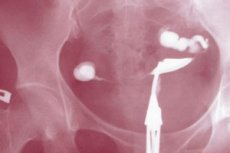Kimographic Pertubation
Last reviewed: 23.04.2024

All iLive content is medically reviewed or fact checked to ensure as much factual accuracy as possible.
We have strict sourcing guidelines and only link to reputable media sites, academic research institutions and, whenever possible, medically peer reviewed studies. Note that the numbers in parentheses ([1], [2], etc.) are clickable links to these studies.
If you feel that any of our content is inaccurate, out-of-date, or otherwise questionable, please select it and press Ctrl + Enter.

Kimografic pertubation is a method of examining the patency of the fallopian tubes by inserting into the uterine cavity, the fallopian tubes and into the abdominal cavity of air or carbon dioxide with simultaneous visual and graphic registration of the contractile activity of the fallopian tubes. Registration is performed using a special writing device.
There are several types of kymographic curves during pertubation, indicating a certain coarse state.
- Fallopian tubes are freely passable: gas begins to enter the abdominal cavity at a pressure of 50-80 mm Hg. Art. Good peristalsis of pipes is noted. With auscultation, tube noise is heard from both sides of the abdominal cavity. A positive frenicus symptom appears after the administration of 70-100 ml of gas if the patient has taken a vertical position.
- Spasm of the fallopian tubes: the maximum pressure remains on the same numbers (100-140 mm Hg) for a long time, a sharp drop is noted after the introduction of antispasmodics. Peristalsis is recorded after a pressure drop, as well as a frenicus-symptom.
- Atony of the fallopian tubes: the gas freely penetrates into the abdominal cavity, the maximum pressure is lower than normal (40-60 mm Hg), the peristalsis is sluggish. The frenicus-symptom appears quickly and well expressed.
- Difficult tubing (stenosis): high maximum pressure (160-180 mm Hg) is characteristic, which gradually begin to decrease, but the minimum pressure remains above 100 mm Hg. Art. Peristalsis is almost not expressed. The frenicus-symptom is weakly expressed.
- Obstruction of the fallopian tubes : the pressure increases continuously, while remaining at high values (160-200 mm Hg). At auscultation noise in the abdominal cavity is not listened. Soreness in the process of pertubation is localized in the lower abdomen, the frenicus-symptom is negative, there is no peristalsis.

Kimographic pertubation is a valuable method of revealing the functional state of the uterus and tubes. Especially valuable information can be obtained by comparing the data of pertubation and hysterosalpingography.
What do need to examine?
How to examine?


 [
[